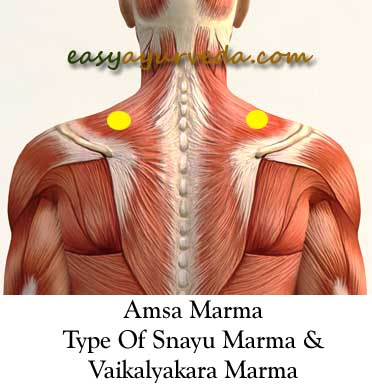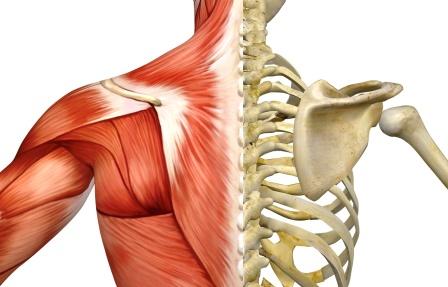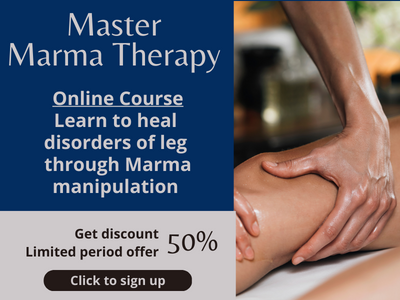Amsa Marma: Components, Location, Effect Of Injury
Article by Dr Raghuram Y.S. MD (Ay) and Dr Manasa, B.A.M.S
Amsa is an important Marma i.e. vital or delicate point in the body. It is located in the upper back, one on either side of the vertebral column at the junction of the shoulder and neck. It is predominantly made up of snayu (ligaments and tendons).
Amsa Marma
बाहु मूर्ध ग्रीवा मध्ये अंसपीठ स्कन्ध निबन्धौ अंसौ नाम, तत्र स्तब्ध बाहुता।(सु.शा.६/२७)

Table of Contents
Location
Amsa Marmas are located one on either side of the upper part of the Prushta Vamsha (Spine, Backbone). They are located at the center of congruence of Bahu (arm), Murdha (head) and Greeva (neck).
The Marma is attached to the Amsa peetha (glenoid cavity, a pit like structure in the outer side or lateral side of scapula which articulates with head of the arm bone to form the shoulder joint) and Skandha (shoulder).
Categories
Categories in which the Amsa Marma is included
i) Prushta Gata Marma (Prushta = Back) – Since Amsa Marma is located in the back, upper back region, shoulder and scapular region to be precise; they are classified under Prushta Gata Marmas.
ii) Snayu Marma – Amsa marma is predominantly made up of Snayu i.e. ligaments and tendons, which form the structural component of this Marma. Therefore it is classified under Snayu Marma. The other elements namely Asthi (Bones), Siraa (blood vessels, veins), Sandhi (bony joints) and Mamsa (muscles) are also present but in a lesser proportion.

iii) Vaikalyakara Marma – (Vaikalya kara – deformity forming) Amsa Marmas when injured are said to produce deformity of the body or part of the body wherein the Marma is damaged. Based on the impact of injury, Amsa Marma is classified under Vaikalyakara Marma.
Measurement
Pramana (measurement of Amsa Marma) –
Amsa Marma occupies a space of ½ angula dimension (approximately equal to the horizontal dimension or breadth of middle segment of one’s own middle finger)
Effect of Injury
तत्र स्तब्ध बाहुता।(सु.शा.६/२७)
Injury of Amsa Marma causes deformity.
Injury of Amsa Marma leads to Stabdha Baahutaa i.e. stiffness or rigidity of the shoulder or arm.
Modern perspective
Modern Perspective (Practical anatomy) of Amsa Marma
Structures falling in the area of Amsa Marma –
- Coraco-clavicular ligaments
- Conoid ligaments
- Trapezoid ligaments
- Acromio-clavicular ligaments
- Coraco-clavicular ligaments
Though all the elements which comprise a marma i.e. asthi (bones), mamsa (muscles), siraa (veins) and sandhi (joints) are all present in the site of this Marma, it is predominant in the snayu (ligaments and tendons) making up the Amsa Marma, therefore it is a Snayu Marma.
When Amsa marma gets damaged, the effect of injury will chiefly involve the ligaments and tendons around the shoulder, scapula, clavicle and neck in comparison to the extent of damage caused to other tissues.
Just Before Finishing
Our upper limbs are important tools of our day-to-day activities. We can’t imagine doing most of our activities of daily living without using these tools. The important ligaments and tendons which operate our arm and shoulder at the shoulder, sterno-clavicular, coraco-clavicular and acromio-clavicular joints constitute the Amsa Marma. Any injury to this Marma will render the activities of our upper limb passive. Therefore any injury to the shoulder should not be neglected.
Click to Consult Dr Raghuram Y.S. MD (Ayu)







